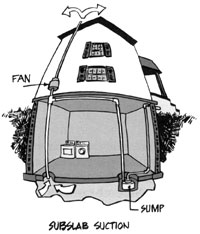Fixing a Radon Problem - Fix My House
Indoor radon levels can be reduced by installing a relatively simple system.
You can do it yourself if you are handy or hire a Certified
Radon Mitigator.
There are two common configurations of the basic system, one for
slab-on-grade and basement homes and one for raised foundation homes. The
following are excerpts from the US EPA's Consumer's Guide to Radon
Reduction.
Action Sub-Slab Suction

Active Sub-slab suction (also called sub-slab depressurization) is the most
common and usually the most reliable radon reduction method. One or more suction
pipes are inserted through the floor slab into the crushed rock or soil
underneath. They also may be inserted below the concrete slab from outside the
house. The number and location of suction pipes that are needed depends on how
easily air can move in the crushed rock or soil under the slab, and on the
strength of the radon source. Often, only a single suction point is needed.
Sub-Membrane Suction
An effective method to reduce radon levels in crawlspace houses involves
covering the earth floor with a high-density plastic sheet. A vent pipe and fan
are used to draw the radon from under the sheet and vent it to the outdoors.
This form of soil suction is called sub-membrane suction, and when properly
applied is the most effective way to reduce radon levels in crawlspace houses.
Active Crawlspace Depressurization (a less favorable option)
A less-favorable option is active crawlspace depressurization which involves
drawing air directly from the crawlspace using a fan. This technique generally
does not work as well as sub-membrane suction and requires special attention to
combustion appliance back drafting and sealing the crawlspace from other
portions of the house, and may also result in increased energy costs due to loss
of conditioned air from the house.
Checking Your Contractor's Work
Below is a list of basic installation requirements that your
contractor should meet when installing a radon reduction system in your home.
It is important to verify with your contractor that the radon mitigation
standards are properly met to ensure that your radon reduction system will be
effective. Ask your contractor for a written guarantee that the installed radon
system complies with the current accepted standard practice for installing radon
mitigation systems in existing low-rise residential buildings (ASTM E 2121-03).
- Radon reduction systems must be clearly labeled. This will avoid
accidental changes to the system which could disrupt its function.
- The exhaust pipe(s) of soil suction systems must vent above the
surface of the roof and 10 feet or more above the ground, and at least 10 feet
away from windows, doors, or other openings that could allow the radon to
reenter the house, if the exhaust pipe(s) do not vent at least 2 feet above
these openings.
- All vent stack piping shall be solid, ridged pipe not less than 3 inches
inside diameter.
- The exhaust fan must not be located in or below a livable area. For
instance, it should be in an unoccupied attic of the house or outside - not in a
basement!
- If installing an exhaust fan outside, the contractor must install a
fan that meets local building codes for exterior use.
- Electrical connections of all active radon reduction systems must be
installed according to local electrical codes.
- A warning device must be installed to alert you if an active system stops
working properly. Examples of system failure warning devices are: a liquid
gauge, a sound alarm, a light indicator, and a dial (needle display) gauge. The
warning device must be placed where it can be seen or heard easily. Your
contractor should check that the warning device works. Later on, if your
monitor shows that the system is not working properly, call a contractor to have
it checked.
- A post-mitigation radon test should be done within 30 days of system
installation, but no sooner than 24 hours after your system is in operation with
the fan on, if it has one. The contractor may perform a post-mitigation test to
check his work and the initial effectiveness of the system; however, it is
recommended that you also get an independent follow-up radon measurement.
Having an independent tester perform the test, or conducting the measurement
yourself, will eliminate any potential conflict of interest. To test the
system's effectiveness, a 2-7 day measurement is recommended. Test conditions:
windows and doors must be closed 12 hours before and during the test, except for
normal entry/exit.
- Make sure your contractor completely explains your radon reduction system,
demonstrates how it operates, and explains how to maintain it. Ask for written
operating and maintenance instructions and copies of any warranties.
Complaints about Radon Services
If you feel the service was not in accordance with Mitigation or
Testing Standards, contact CDPH's Indoor
Radon Program. Program staff will assist you in submitting a formal
complaint to either the National Radon Proficiency Program (NRPP) or National Radon Safety Board (NRSB).
Do It Yourself?
If you are interested in fixing the radon problem in your home
yourself, check your local library or go online to purchase a copy of "Protect
Your Home From Radon: A Step-by-Step Manual For Radon Reduction" Second Edition,
D.L Kladder with Dr. J. F. Burkhart and S.R. Jelinek, which is designed for the
do-it-yourselfer.
Radon Program